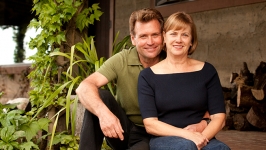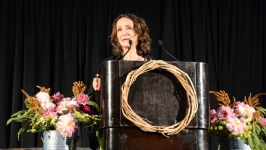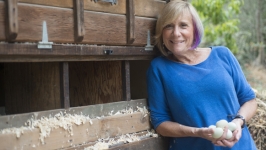Martin Ray: A Tribute to the California Wine Master
Mountain Maverick—The Lasting Legacy of Martin Ray
The story of Mount Eden Vineyards must include Martin Ray. Born in 1904, Ray grew up locally and was mentored by Paul Masson, who had enormous influence on his young protégé. Masson is a legend in California’s wine history as proprietor of Paul Masson Champagne Cellars located on a Saratoga mountaintop, now home to the Mountain Winery and summer concerts.
When Martin Ray learned that Paul Masson was selling the winery and vineyards in 1936, he wanted to buy it. But Masson—apparently the only person the strong-minded Ray ever listened to—suggested he buy the neighboring mountaintop to the north. So Ray bought not just Masson’s properties in 1936, he went on to buy the rugged, undeveloped, 251-acre mountain site nearby in 1943. At the time there were no vineyards and no roads.
Ray proceeded to plant Chardonnay, Pinot Noir and Cabernet Sauvignon vines and built a cement winery cellar with a house on top. He took Chardonnay and Pinot Noir vine cuttings from Masson’s vineyard, and Cabernet cuttings from Woodside’s former La Questa winery to propagate his new vineyards. He eventually sold the Masson vineyards to Seagram’s in 1943.
Ray began making wine in an era when California wines were mostly generic blends, labeled Chablis, Burgundy, Claret and such. Up until 1982, winemakers could call a wine Chardonnay or Pinot Noir with only 51% of those grapes in the blend. Now wines that are labeled varietal must contain at least 75% of said grape.
Mount Eden winemaker Jeffrey Patterson, says Martin Ray was adamant about making 100% varietal wines and labeling them as such. “It was quite revolutionary,” Patterson notes. “He always campaigned for single-varietal wine and was boastful about it.”
“When I think of Martin Ray,” Ellie Patterson says, “he was the champion of California wine. He was the one who believed that California could make world-class wine. In that sense he pushed the industry towards quality.”
A lavish entertainer, Ray hosted mountaintop soirees lasting as long as 16 hours. He was famous among wine connoisseurs, but his wines were made in such small quantities and were so expensive—at $60 per case in the 1950s, pricey for the times—that they were not well known outside the local market. And Ray chose not to travel to promote his wines like other winemakers of his era.
“Martin’s personality was so bombastic that a lot of people ignored him, they thought he was a crazy guy,” Patterson recalls. “He made some profound wines and he made a lot of real dogs too.”
In the 1960s Ray took on partners, seeking money to plant more vineyards. Patterson calls that decision a fatal mistake. The partnership failed and the partners sued Ray, won and kicked him out in 1972. They took control and renamed the winery Mount Eden. Ray passed away four years later.
His stepson Peter Martin Ray continued the Martin Ray label for some time, living in Ray’s second home (where Ray had lived after being kicked out of Mount Eden) on a lower part of the property. Peter Ray tended a Chardonnay vineyard planted at the house. In 1990, Courtney Benham purchased the Martin Ray wine brand from the Ray family and moved it to Sonoma County. His legacy and drive for pursuing world-class California wines and grapes, and creating “wines of place” lives on here in the hilltops and valleys of the Bay Area.





